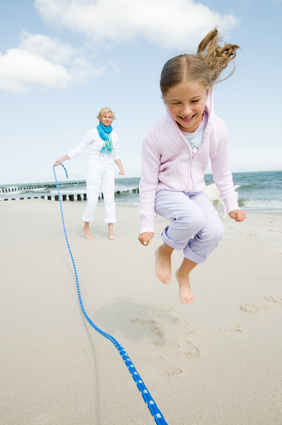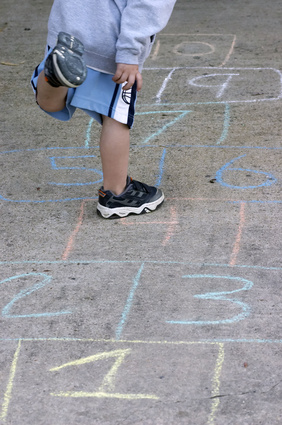Writing is a movement that entails rhythm. Yes, the same as the rhythm that you need when you dance. Before you even think to start teaching your child to write the alphabet and words on paper: remember the golden rule for writing, namely rhythm.
Rhythmical movement should become part of your child's real inner body and inner world. In other words rhythm should become part of him. So, do you need to dance in order to teach your child to write? Well, yes! Good news hey, as dance is a lot of fun and it's relaxing for both you and your child.
What to do when you do the "writing dance"?
- Clap your hands / click your fingers / tap your feet on the rhythm of the music while for example moving in a circle with your child.
- If your child mastered the clapping and clicking, start to combine more rhythmical movements, for example clap your hands, click your fingers and clap hands on your legs (all on the rhythm of the music).
- More dancing "activities": gallop like a horse on the rhythm of music, play skipping games, for example while skipping rhythmically give your child some "learn to listen" activities, like telling him "We are going to shop, let's skip to the market place". "Look out for the cars" (keep on skipping). "Let's look to our right / left to see if the road is clear". "Now we are at he market" (stop skipping). Take out your grocery list (the child who can't read yet, may use a list with some pictures of e.g. apples, bananas, etc). Ask your child what's on his list. Now you can practice some mathematics (counting skills). Your child "reads" his shopping list: We need, three bananas, five apples, ten small yoghurts, etc.
- Use musical instruments to further develop your child's rhythm. If you don't have any instruments, make your own (e.g. for the drum use an empty tin and two sticks; put some small stones in a plastic bottle to have a rattle, use kitchen utensils and just enjoy the orchestra).
- The next step will be to make rhythmical patterns in the sand / mud, while for example singing a song.
- Let your child also draw rhythmical patterns in the air (with both his hands and feet).
- Play hop scotch.
- Jump on one leg on the rhythm of the music.
- Rhythmically hop / throw a ball (start with a big size ball first and later use a tennis ball). You can also add a tennis racket as a very advanced activity.
Midline crossing and writing
Midline crossing (or middle line crossing) is one of the most important skills that a child has to master in order to learn to read and to write.
What does midline crossing mean?
Our bodies have a left side and a right side. If you could draw a line from head to toes (or from top to bottom), that is your midline or your centre line. Most children who have problems with writing and reading, can't cross their midline. To cross your midline, means that you should be able to move with your left side of your body into the area of the right side and visa versa.
See examples of midline crossing on the photo's below. Do these exercises to the rhythm of music as a dance.
Rhythmical movement should become part of your child's real inner body and inner world. In other words rhythm should become part of him. So, do you need to dance in order to teach your child to write? Well, yes! Good news hey, as dance is a lot of fun and it's relaxing for both you and your child.
What to do when you do the "writing dance"?
- Clap your hands / click your fingers / tap your feet on the rhythm of the music while for example moving in a circle with your child.
- If your child mastered the clapping and clicking, start to combine more rhythmical movements, for example clap your hands, click your fingers and clap hands on your legs (all on the rhythm of the music).
- More dancing "activities": gallop like a horse on the rhythm of music, play skipping games, for example while skipping rhythmically give your child some "learn to listen" activities, like telling him "We are going to shop, let's skip to the market place". "Look out for the cars" (keep on skipping). "Let's look to our right / left to see if the road is clear". "Now we are at he market" (stop skipping). Take out your grocery list (the child who can't read yet, may use a list with some pictures of e.g. apples, bananas, etc). Ask your child what's on his list. Now you can practice some mathematics (counting skills). Your child "reads" his shopping list: We need, three bananas, five apples, ten small yoghurts, etc.
- Use musical instruments to further develop your child's rhythm. If you don't have any instruments, make your own (e.g. for the drum use an empty tin and two sticks; put some small stones in a plastic bottle to have a rattle, use kitchen utensils and just enjoy the orchestra).
- The next step will be to make rhythmical patterns in the sand / mud, while for example singing a song.
- Let your child also draw rhythmical patterns in the air (with both his hands and feet).
- Play hop scotch.
- Jump on one leg on the rhythm of the music.
- Rhythmically hop / throw a ball (start with a big size ball first and later use a tennis ball). You can also add a tennis racket as a very advanced activity.
Midline crossing and writing
Midline crossing (or middle line crossing) is one of the most important skills that a child has to master in order to learn to read and to write.
What does midline crossing mean?
Our bodies have a left side and a right side. If you could draw a line from head to toes (or from top to bottom), that is your midline or your centre line. Most children who have problems with writing and reading, can't cross their midline. To cross your midline, means that you should be able to move with your left side of your body into the area of the right side and visa versa.
See examples of midline crossing on the photo's below. Do these exercises to the rhythm of music as a dance.
Cross-crawl | Knee-foot-heel |
Backward-heel touch | Lazy 8 (∞ laying on its side) |
Resources Midline crossing exercises
Dr Melody de Jager
Neurolink South Africa
Dr Melody de Jager
Neurolink South Africa





 RSS Feed
RSS Feed
